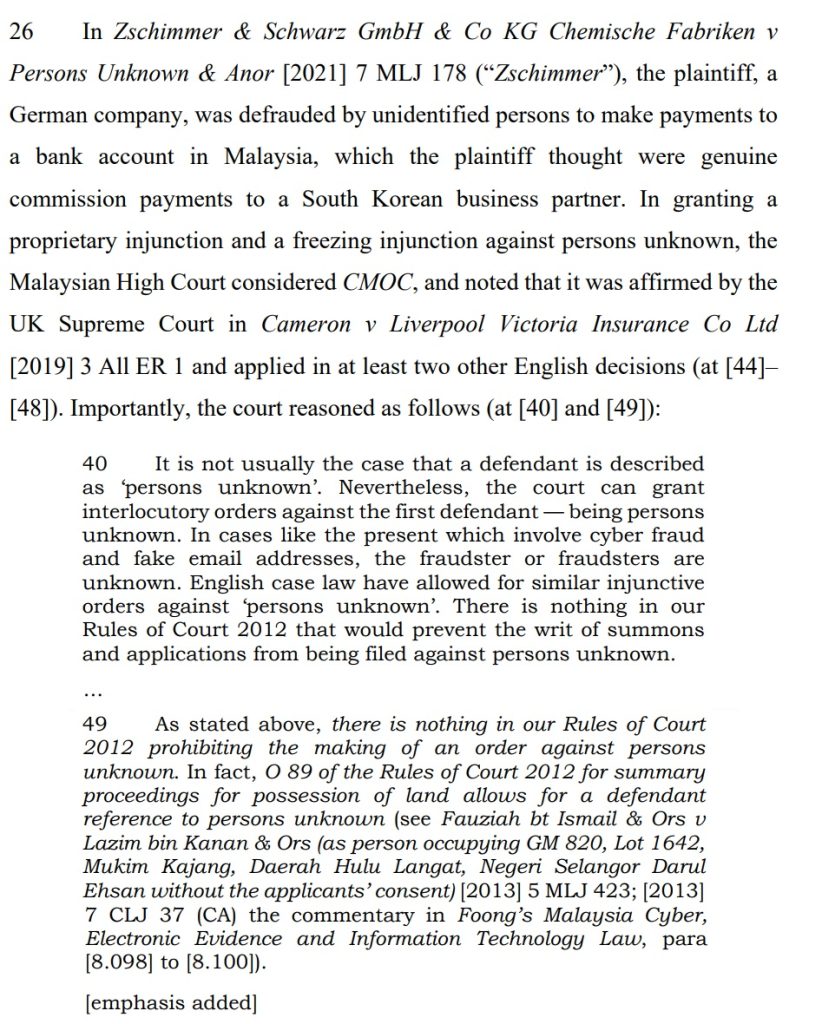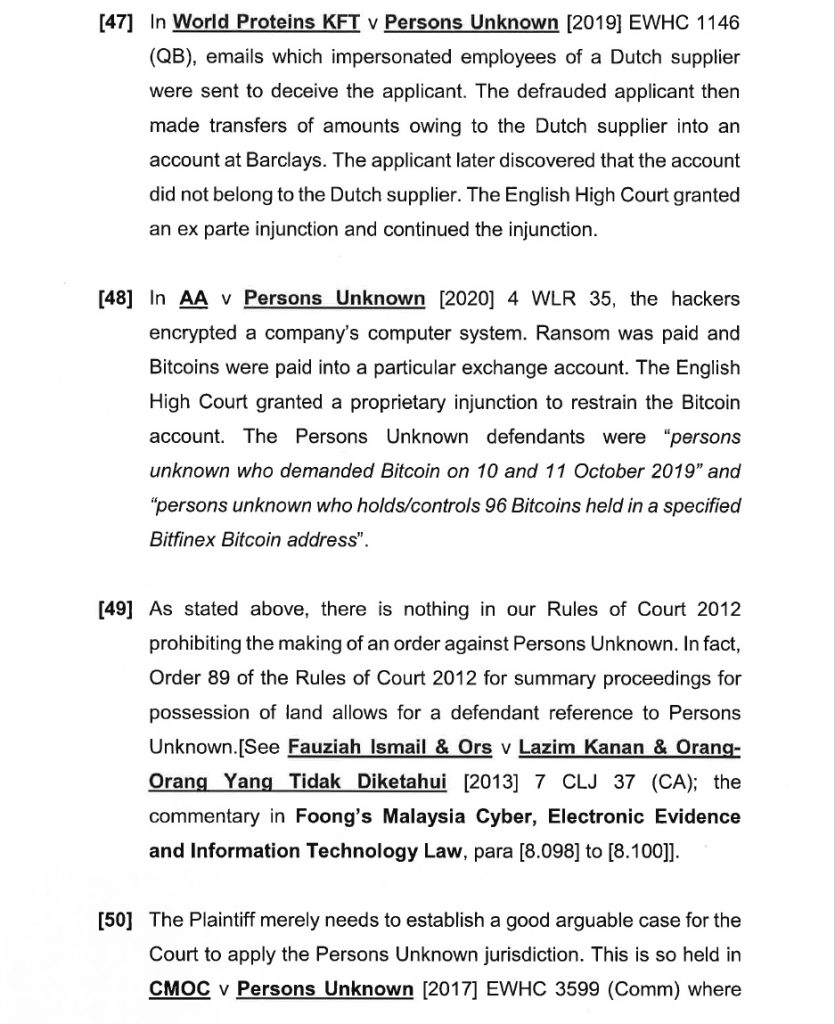I am happy to announce that my book “Foong’s Malaysia Cyber, Electronic Evidence and Information Technology Law” was recently featured in the Singapore High Court case of CLM v CLN and others [2022] SGHC 46.

The case had referred to our High Court case of Zschimmer & Schwarz GmbH & Co KG Chemische Fabriken v Persons Unknown & Anor which had quoted my commentary in para [8.098] to [8.100] of my book (reproduced below) regarding actions against persons unknown.

CLM v CLN and others [2022] SGHC 46
The Singapore High Court dealt with two (2) interesting and novel points of law.
First, can stolen cryptocurrency assets be the subject of a proprietary injunction?
Second, does the court have jurisdiction to grant interim orders against persons whose identities are presently unknown?
Brief Facts
The plaintiff had commenced an action to trace and recover 109.83 Bitcoin (“BTC”) and 1497.54 Ethereum (“ETH”) (collectively, the “Stolen Cryptocurrency Assets”) that were allegedly misappropriated from him by unidentified persons (ie, the first defendants), a portion of which has been traced to digital wallets that were controlled by cryptocurrency exchanges with operations in Singapore (ie, the second and third defendants).
The Court granted the plaintiff an ex parte proprietary injunction against the first defendant from, among others, dealing with the Stolen Cryptocurrency Assets, and a worldwide freezing injunction.
Action against persons unknown
The Singapore High Court held that there is nothing in their Rules of Court (Cap 322, R5, 2014 Rev Ed) (“ROC”) that requires a defendant to be specifically named. O 2 r 1 of the ROC expressly provides that even if the commencement of proceedings against persons unknown contravenes the ROC, such a contravention is treated as a mere irregularity, and will not result in the nullification of proceedings unless the court exercises its discretion to order the same.
Like how our Court had relied on O. 89 of the Malaysian Rules of Court 2012, the Singapore High Court held that O. 81 of the ROC allows for a reference to persons unknown in summary proceedings for possession of land.
Hence, the Court held that it has the jurisdiction to grant interim orders against the first defendants, who are persons unknown.
Further, the Singapore High Court held that the description of the first defendant must be sufficiently certain as to identify both those who are included and those who are not. In the present case, the plaintiff has sufficiently defined the first defendant as “any person or entity who carried out, participated in or assisted in the theft of the Plaintiff’s Cryptocurrency Assets on or around 8 January 2021, save for the provision of cryptocurrency hosting or trading facilities“.
Stolen cryptocurrency assets as subject matter of a proprietary injunction
The Singapore High Court held that there is a serious arguable case that the plaintiff has a proprietary interest. Cryptocurrencies are a form of property. The Court adopted the test from the English case of National Provincial Bank Ltd v Ainsworth [1965] AC 1175, which defined the term property rights, and held that-
- The first requirement is that the right must be “definable” – the asset must hence be capable of being isolated from other assets whether of the same type or of other types and thereby identified. To this end, cryptocurrencies are computer-readable strings of characters which are recorded on networks of computers established for the purpose of recording those strings, and are sufficiently distinct to be capable of then being allocated to an account holder on that particular network.
- The second requirement is that the right must be “identifiable by third parties”, which requires that the asset must have an owner being capable of being recognised as such by third parties. An important indicator is whether the owner has the power to exclude others from using or benefiting from the asset. In this vein, excludability is achieved in respect of cryptocurrencies by the computer software allocating the owner with a private key, which is required to record a transfer of the cryptocurrency from one account to another.
- The third requirement is that the right must be “capable of assumption by third parties”, which in turn involves two aspects: that third parties must respect the rights of the owner in that asset, and that the asset must be potentially desirable. The fact that these two aspects are met by cryptocurrencies, is evidenced by the fact that many cryptocurrencies, certainly BTC and ETH, are the subject of active trading markets.
- The fourth requirement is that the right and in turn, the asset, must have “some degree of permanence or stability”, although this is a low threshold since a “ticket to a football match which can have a very short life yet unquestionably it is regarded as property”. In this respect, the blockchain methodology which cryptocurrency systems deploy provides stability to cryptocurrencies, and a particular cryptocurrency token stays fully recognised, in existence and stable unless and until it is spent through the use of the private key, which may never happen.
The Singapore High Court held that the balance of convenience lay in favour of granting the proprietary injunction. If it were not granted, there would be a real risk that the first defendants would dissipate the Stolen Cryptocurrency Assets, which would prevent the plaintiff from recovering those assets even if he successfully obtained a judgment in his favour. Conversely, even if the plaintiff’s case were later refuted, the first defendants would only suffer losses arising from their inability to deal with the Stolen Cryptocurrency Assets, which could be compensated by way of damages.
Worldwide freezing injunction
The Singapore High Court also granted the worldwide freezing injunction to restrain the first defendants from dealing with, disposing of, or diminishing the value of, their assets up to the value of the Stolen Cryptocurrency Assets.
The learned Judge was of the view that the first defendants dissipated the stolen assets through a series of digital wallets that appear to have been created solely for the purpose of frustrating the plaintiff’s tracing and recovery efforts, and which had either no or negligible transactions other than the deposit and withdrawal of the Stolen Cryptocurrency Assets.
Moreover, the risk of dissipation in the present case is heightened by the nature of the cryptocurrency: the Stolen Cryptocurrency Assets are susceptible to being transferred by the click of a button, through digital wallets that may be completely anonymous and untraceable to the owner, and can be easily dissipated and hidden in cyberspace.
Ancillary disclosure orders
Ancillary disclosure orders were also made against the second and third defendants to disclose to the plaintiff the current balances of the second and third defendants’ accounts that were credited with BTC and ETC that are traceable to the Stolen Cryptocurrency Assets, and information and documents collected by the second and third defendants in relation to the owners of the relevant accounts in the second and third defendants and details of all transactions involving the relevant accounts in the second and third defendants from the dates on which the stolen assets were credited against the accounts.
Leave a Reply